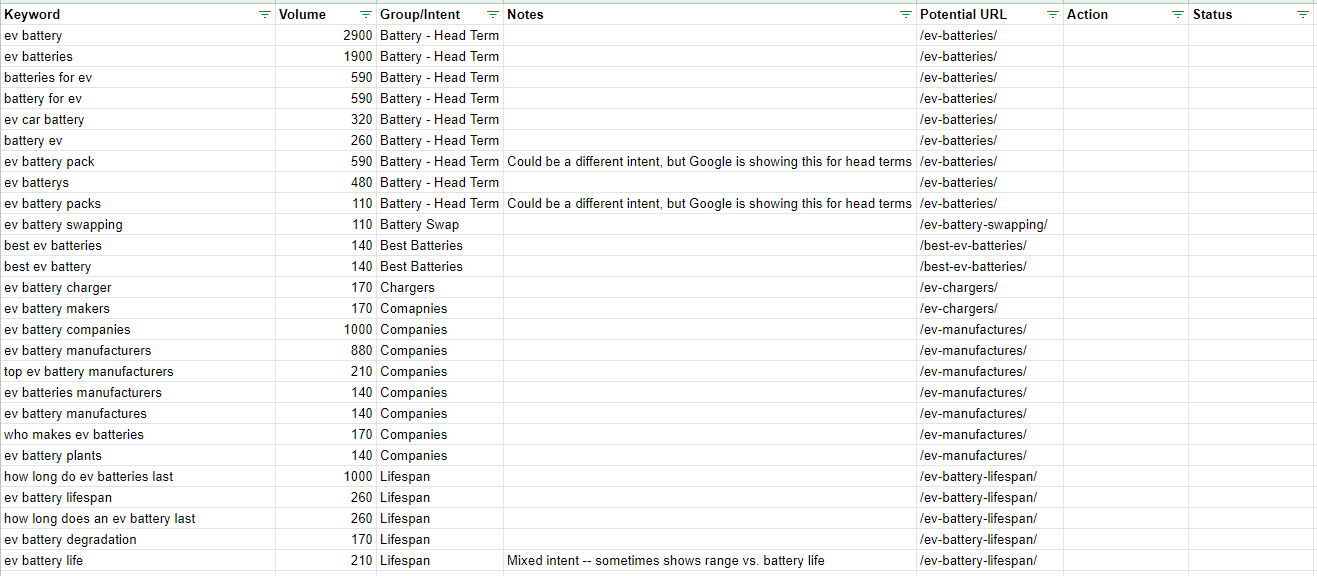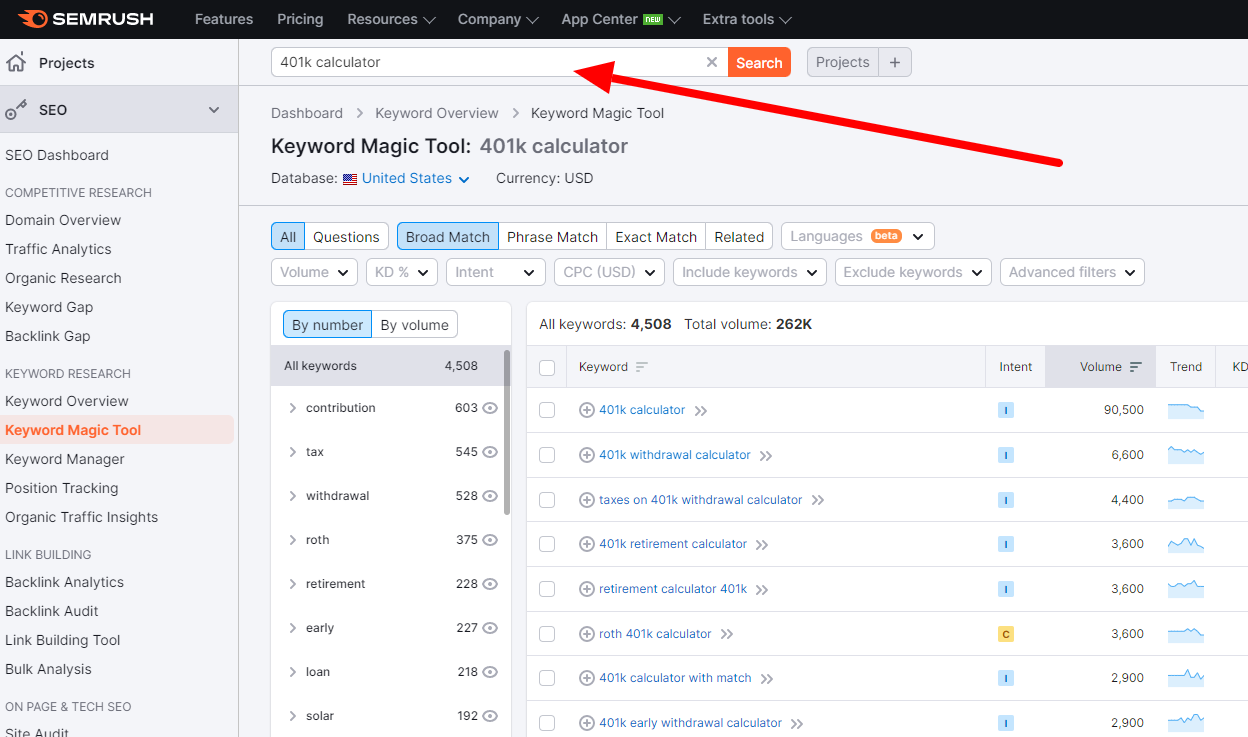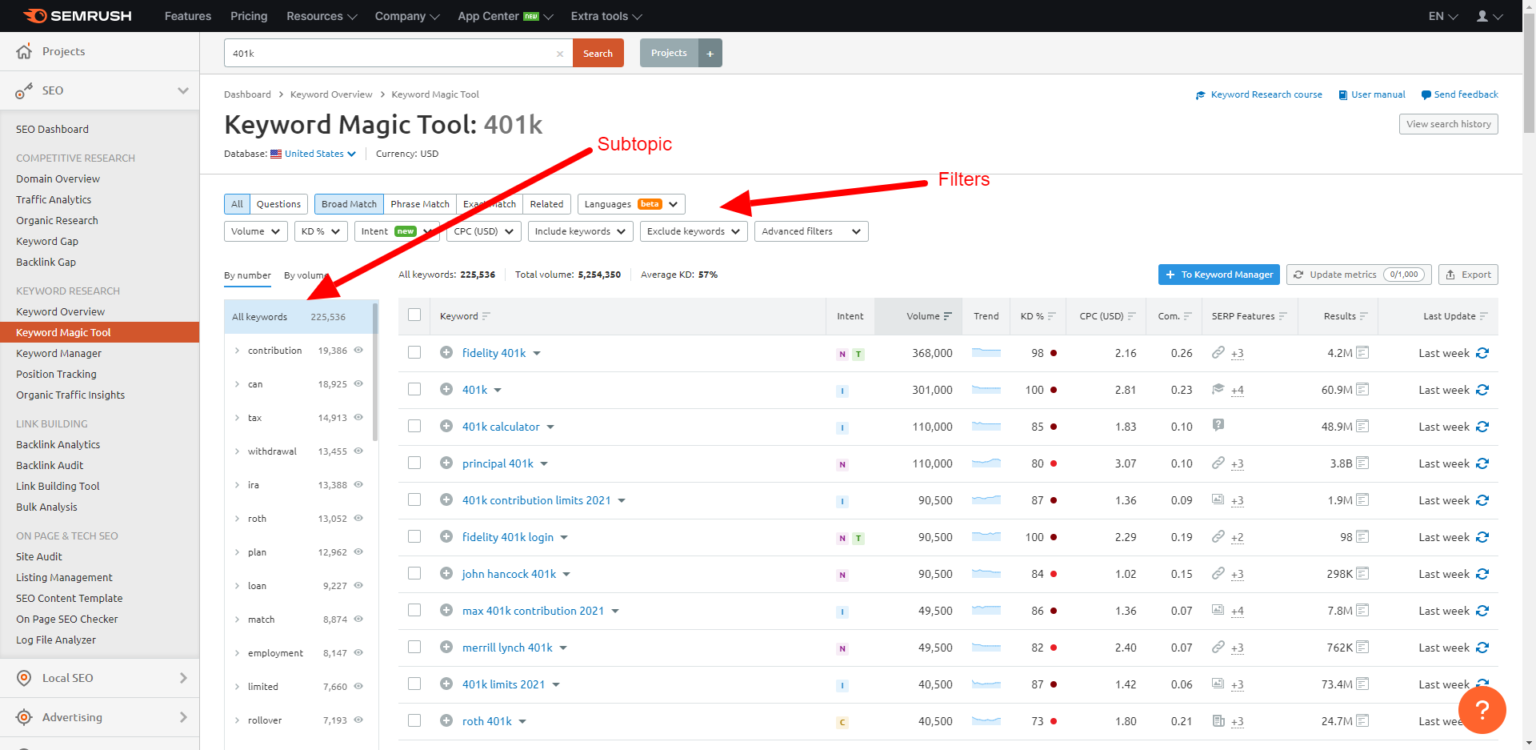Lesson 2.1: The Keyword Research Process
Article by: Matt Polsky
The keyword research process is relatively straightforward, but the deliverable can vary based on your goal.
The main thing to remember is to produce an analysis that allows others or yourself to take action - keywords on a spreadsheet typically aren't enough. Deliverables can include:
- A keyword map or document identifying the group of keywords a single page should target.
- A content creation list or list of topics you need to write and their associated target keywords and search volume.
- A content brief or content outline with headings and subheadings to guide content creators or freelancers.
- A gap analysis or list of keywords competitors rank for where you don't but should.
In its basic form, a keyword research spreadsheet typically looks like this:

View an interactive version of the above example here.
The Process at a Glance
When starting from a blank slate (e.g., no prior keyword research or content) or if the site is newer with minimal content, you'll typically have a process like this:
- Learn the conversion funnel
- Create a seed list in Excel or Google Sheets
- Expand the seed list and append data
- Categorize by search intent (create a keyword map)
The process can differ if you're looking to fill content gaps (searches that could lead to your product or service that the site doesn't cover) on an established site. In these cases, the process looks more like this:
- Identify competitors (start with 1-1 competitors if possible)
- Utilize a gap analysis tool (Semrush or Ahrefs both have solid gap analysis tools)
- Map out missing content
For single-page optimization, the process can get even more straightforward. In these cases, it could be as simple as:
- List out ideas around primary topics
- Searching Google for the primary search terms to find competing pages
- Plugging those competing pages in a tool like Ahrefs to expand your list
- Working through the page to ensure it hits all the notes.
It looks like more steps, but it's a lot less time and Excel work.
The largest hurdle for small businesses, entrepreneurs and new SEOs can be accessing tools that give you the data. Good tools typically cost anywhere from $30 to $100 per month. That said, it's nearly impossible to do great keyword research without a keyword tool, and they typically pay for themselves.
Breaking Down the Basic Steps
Below we break down some of the common steps with keyword research. Remember, you don't always need to do every step - the steps you take depend on the deliverable.

Step 1: Learn the Conversion Funnel
Before diving too deep into keyword research, you should learn how the site or business gets value from search (i.e., a sale, sign-up, lead, traffic for AdSense, etc.).
A great example of why this is important is this article on Veterans United entitled 5 Things to Know Before Attending a Military Ball. Veterans United is a mortgage company -- military ball gowns don't typically turn into mortgage leads. The amount of revenue driven from that post has never paid for the time or resources it took to create.
If you're unsure of the conversion funnel, ask someone in the business or niche questions like:
- Who is the target audience?
- How do people convert?
- Do any search terms currently convert better than others?
- Is there PPC or conversion data to help guide decisions?
The goal is to figure out how you can provide the most value. You do that by finding keywords that convert and drive business.
Step 2: Create a Seed List
A seed list is a good place to start if you don't have any keywords. A seed list is the initial set of words that come to mind when determining how searchers find your site's products, services, and content.
For example, if you're a financial planner, you may have a seed list that starts with:
- 401k
- Roth IRA
- Retirement accounts
Your seed list may come from experience, but it's often easiest to go straight to a tool like Ahrefs or Semrush and plug-in competing domains. With any seed list, the goal is expansion, which these tools do very well.

Step 3: Expand and Gather Data
At this point, you have a small seed list. Your goal is to expand that list to include every possible keyword variation for your niche with corresponding search volume metrics.
Search volume isn't always accurate, but it's the most useful approach to validating and prioritizing keywords before spending a ton of time on them.
Luckily, many top keyword research tools quickly expand lists and apply data, such as search volume, and allow you to export it to Excel.
Some of the better tools for keyword research include:
- Ahrefs – most used
- Semrush – most used
- AnswerThePublic + Keywords Everywhere – most used
- Google Search Console – most used
- Google Ads Keyword Planner
- AlsoAsked
- Ubersuggest
- Keywordtool.io
When expanding seed lists, you typically have two options: plug your seed list keywords into the tool or plug-in competing pages or domains.
You may even want to bounce between inputting URLs and keywords – it all depends on how granular you want to go. Each method has pros and cons with keyword research, which we'll look at below.
Option 1: Plugging in Keywords

When plugging in keywords, my go-to tool is Semrush. Semrush has the Keyword Magic tool that does a fantastic job of producing keyword ideas. You can also use Google Keyword Planner, but you need an active ad account to get the data.
Plugging in keywords is typically most useful when expanding a broad topic that spans multiple keyword intents.
For example, if you want to create a content cluster around the 401k, you'll find more intents by inputting the broad term "401k" than a specific page ranking for the broad term 401k. With inputting the broad term, you'll discover intents like:
- 401k
- 401k calculator
- 401k eligibility
- 401k brands
- IRA vs 401k
All of these intents could be deserving of a unique page, whereas keywords uncovered from inputting a specific URL are likely for a single page.
What's also nice about Semrush's Keyword Magic tool is the ability to filter. Semrush attempts to group keywords by intent on the left sidebar for a quick view and provides filters that allow you to dial in on the keywords most important to you.

Some of my favorite filters include:
- Volume allows for kicking out keywords with little-to-no search volume.
- Excluding keywords allows you to remove keywords you wouldn't want to target.
- Match types allow you to search for keywords in a specific order. Broad match shows results that include any of the keywords you inputted. Phrase match shows the exact keyword or keyword phrase in various orders. And, exact match shows the exact keyword or keyword phrase in the exact order you provided.

All that said, direct keyword input isn't just for broad terms. You can dig deep into a specific intent by inputting a long-tail keyword instead of a broad term. For example, plugging in "401k contribution limits" will provide results specific to that intent.
Option 2: Plugging in Competitors

The second option is directly plugging in a competing page or competitor's entire domain. Plugging in a specific URL is most useful when optimizing a single page. Plugging in the domain is most useful when looking at every keyword a site ranks for.
The process for a single page is:
- Take the keywords from your seed list and Google the term
- Pull out the top 3-5 (or more) ranking pages
- Plug those pages into Ahrefs or Semrush (or other keyword tool)
- Export the data for each to excel,
- Combine and remove any duplicates
Another option is taking the entire domain instead of a specific page and plugging that into Ahrefs or Semrush. The domain approach is most helpful when you have a brand new site and need to know every topic a competitor is writing about or ranking for.
For these cases, both Ahrefs and Semrush are equally helpful. I use Ahrefs more for plugging in URLs and domains, but either tool provides reliable data and keyword suggestions.
Here's a quick example of what that looks like in action.
Clean the List
No matter what method you use, don't forget to clean the list before going to the next step. Your goal here is to filter duplicate and irrelevant searches and searches without significant search volume. Typically remove searches that don't get more than 10 per month - sometimes, I'll filter higher and sometimes let the 10s stick if it's a tiny niche or local.
Cleaning takes the data to Excel, where you can use Excel's filtering abilities to pull a near-complete list of keywords. It's best to duplicate the tab containing your original data before taking this step, then work out of the new tab, so you always have access to the original data.
Step 4: Categorize by Search Intent: Keyword Mapping
The last step of keyword research is grouping keywords with the same intent: known as keyword mapping. You want to group your keyword list to prevent creating multiple versions of the same article. Duplicating content can harm a site in terms of SEO if done in excess - and it's also a waste of resources to create the same topic more than once.
It's often helpful to build a spreadsheet to develop your keyword map. A physical keyword map is a great starting point for a new website to prevent duplicate content.
A basic keyword map can be as simple as this:

Formatting a Keyword Map
Keyword mapping can be as complex or simple as you'd like. The essential piece of keyword mapping is knowing which terms should all go on the same page. Additional fields aren't always necessary but help with filtering and prioritization.
Below we go through some of the more common fields in a keyword map.
REMEMBER: you can view a live keyword map here.
Keyword (Required)
The Keyword column is for the keywords generated from your research. These typically come from tools like Ahrefs, Semrush or Google Keyword Planner.
Volume (Required)
The volume column is for associated keyword volume or estimated number of searches per month. Volume is essential for helping with prioritization.
Group (Required)
The intent group or keyword group (whatever you want to call it) is a column to identify which terms would all go on the same page.

URL
The URL field is where either the content lives or will live. If you don't have URLs planned, don't include this field right away. If you have URLs planned, enter the suggested URL and add a field for "Status" to show if the URL is live or still in process.
Status
Use a "Status" field to identify if the page is live on the site, in-process or still waiting for creation. Denoting the page status is essential when working with multiple teams.
Action
Action columns depend on workflow and project management system, but an "Action" column may help identify the next steps. For example, if the next step is to create a content brief, you can denote that here (and add a column for who's responsible).
Page Type
Page type helps plan out the hub and spoke pages and guide internal linking decisions. A hub page (also called a pillar page) is a broader topic with many subtopics.
For example, a pillar page for student loans could be, "what are student loans" (targeting "student loans"), and there could be spokes coming off that page for different student loan options. Each option page could also have spokes around pros/cons, eligibility, etc.
I like to note the pillar pages because these often receive higher priority.
Tags
Tags are beneficial if you utilize a rank-tracking platform like Accuranker or STAT. Rank-tracking software crawls Google for the terms you wish to track and reports their position in search results. The tagging piece gets set in the rank tracking software and allows you to segment or filter by tag to check performance.
I typically group pages into tags by their intent or sub-intent.

Notes
The note column is just an excellent column to have. There are always times when you may need to add details on why you made a decision or some unique finding.
Revenue Potential
Adding a field for revenue or lead potential is beneficial for prioritization. I would do this on a 0-3 scale (0 being none and 3 being high) to help establish what sets of keywords have the most value. The field is subjective at times, but can help make decisions around prioritization.
Speeding Up Keyword Mapping and Categorization
Categorization can take time. However, you don't have to go line by line to get this done. The best thing you can do is use Excel filters and keyword themes to tag large groups of keywords and save the ambiguous for manual review.
Check out the video below to see this in action.
Other Keyword Research Resources
- How to Do Keyword Research for SEO from Ahrefs
- The Ultimate Keyword Research Guide for SEO from Semrush
- The Definitive Guide to Keyword Research from Backlinko
How to Use the Major Keyword Research Tools
Here are some basic guides on the keyword research tools we use:
- How to Use Semrush for Keyword Research
- Ahrefs Academy
- The Official Guide to Answer the Public (Video)
- How to Use Google Keyword Planner
